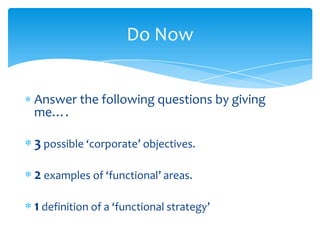3.2 understanding financial objectives - moodle
•Als PPTX, PDF herunterladen•
1 gefällt mir•225 views
A2 Business Resource
Melden
Teilen
Melden
Teilen

Empfohlen
Weitere ähnliche Inhalte
Was ist angesagt? (15)
Ähnlich wie 3.2 understanding financial objectives - moodle
Ähnlich wie 3.2 understanding financial objectives - moodle (20)
CH05 Business objectives and stakeholder objectives.pptx

CH05 Business objectives and stakeholder objectives.pptx
Mehr von MissHowardHA
Mehr von MissHowardHA (20)
Session 7 conducting start-up market research - moodle

Session 7 conducting start-up market research - moodle
1.3 transforming resources into goods and services - moodle

1.3 transforming resources into goods and services - moodle
1.3 transforming resources into goods and services - moodle

1.3 transforming resources into goods and services - moodle
1.2 generating and protecting business ideas - moodle

1.2 generating and protecting business ideas - moodle
1.1 enterprise and entrepreneurs and the uk economy (part 2) - moodle

1.1 enterprise and entrepreneurs and the uk economy (part 2) - moodle
3.16 understanding hr objectives and strategies - moodle

3.16 understanding hr objectives and strategies - moodle
1.11 calculating costs, revenue and profits - moodle

1.11 calculating costs, revenue and profits - moodle
3.2 understanding financial objectives - moodle
- 1. Do Now Answer the following questions by giving me…. 3 possible ‘corporate’ objectives. 2 examples of ‘functional’ areas. 1 definition of a ‘functional strategy’
- 2. Understanding Financial Objectives Unit 3 – Strategies for Success
- 3. Learning Objectives By the end of this lesson you should be able to: 1. Understand the range of financial objectives typically set by larger businesses. 2. Explain how internal and external factors can influence the setting of financial objectives.
- 4. What are financial objectives? What is meant by a financial objective? Complete the handout to find out! Prepare to discuss your answers. Team Task Summarise your given ‘financial objective’ and prepare to give…. • A point to definition of your given objective. • 3 bullet points to describe your given objective.
- 5. Internal and External Influences Think about any internal and external influences on financial objectives. Pair and discuss your ideas. Share and discuss your team’s ideas.
- 6. Internal and External Influences Internal Influences External Influences Characteristics of the firm – size, status Competitors actions – the firm may be and age of the firm. engaged in a price war and therefore E.g. - Small to medium-sized firms may man have to take the approach of cost only have an objective of satisficing. minimisation if they are to remain competitive. Owners –objectives could be based on the motives the owners and the Economics conditions – directors may be relationship with directors. aware of current and predicted future trends in the economy. Sector – is the business in the public or E.g. – If the economy is unstable then the private sector. Aim to maximise profits of rate of buying and selling may reduce. offer a service.?
- 7. Quick questions! Complete the 3 questions at the end of your handout. Write in full sentences.
- 8. Re-cap Learning Objectives You should now be able to : 1. Understand the range of financial objectives typically set by larger businesses. 2. Explain how internal and external factors can influence the setting of financial objectives.